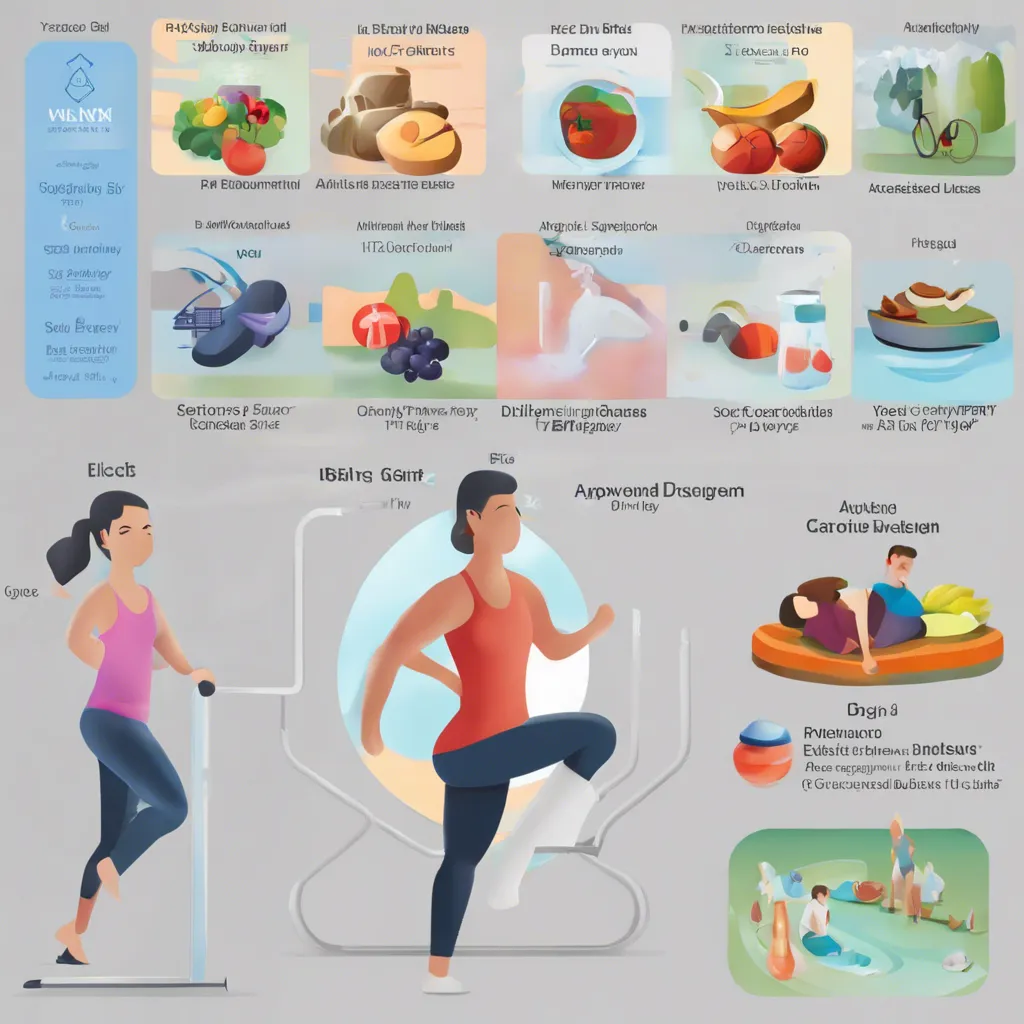Table of contents
- The Surprising Ways Exercise Can Help Regulate Blood Sugar
- Exploring Different Exercise Options for Managing Diabetes
- Designing an Individualized Fitness Program
- Taking Precautions: Safeguarding Your Well-being
- Keeping Tabs on Progress and Adapting the Plan
- Sample Exercise Routines and Workouts
- In Summary
In the pursuit of effective diabetes management, customized exercise plans are essential. Each person's diabetes journey is unique, requiring a personalized approach to physical activity. This article explores the importance of tailored exercise plans in managing diabetes and how they can help individuals achieve optimal health outcomes. From personalized goal setting to incorporating various types of exercises, discover the power of individualized fitness regimens in improving overall well-being for those with diabetes.
The Surprising Ways Exercise Can Help Regulate Blood Sugar
Exercise is not just beneficial for weight loss or improving cardiovascular health. It also plays a crucial role in maintaining optimal blood sugar levels. Here are some surprising ways exercise can help regulate blood sugar:
- Increased insulin sensitivity: Regular physical activity improves the body's response to insulin, the hormone responsible for regulating blood sugar levels. When you exercise, your muscles become more sensitive to insulin, allowing them to absorb glucose from the bloodstream more efficiently.
- Reduction in insulin resistance: Exercise reduces insulin resistance, a condition in which the body's cells do not respond properly to insulin. By reducing insulin resistance, exercise helps normalize blood sugar levels and prevents the development of type 2 diabetes.
- Better glycemic control: Exercise helps regulate glycemic control by increasing glucose uptake by muscles during and after physical activity. This not only helps lower blood sugar during exercise but also improves overall glucose management over time.
- Weight management: Regular exercise helps with weight management, which is crucial for maintaining healthy blood sugar levels. Excess weight, especially around the abdomen, is closely linked to insulin resistance and an increased risk of type 2 diabetes.
- Stress reduction: Exercise is a natural stress reliever. By reducing stress levels, exercise helps prevent the release of stress hormones, such as cortisol, which can significantly impact blood sugar levels.
- Improved cardiovascular health: Exercise improves heart health and increases circulation, ensuring that glucose and insulin are transported effectively throughout the body.
- Positive impact on insulin-producing cells: Some studies suggest that exercise may have a positive effect on the function and survival of insulin-producing cells in the pancreas, further enhancing blood sugar regulation.
Exploring Different Exercise Options for Managing Diabetes
People with diabetes can benefit from a combination of aerobic exercises, such as brisk walking or swimming, strength training exercises, like lifting weights, and flexibility exercises, such as yoga or stretching, to manage their condition effectively.
Designing an Individualized Fitness Program
Designing an individualized fitness program involves understanding the reader's needs and preferences. By considering factors such as fitness goals, available time, and preferred activities, one can create an exercise plan tailored to their specific requirements.
Taking Precautions: Safeguarding Your Well-being
When it comes to exercising with diabetes, taking precautions and considering safety measures is of paramount importance. By following these guidelines, you can ensure that you safeguard your well-being and make exercising a positive experience:
- Monitor your blood sugar levels before and during exercise: It is crucial to check your blood sugar levels before engaging in physical activity. This will help you determine if your levels are within a safe range. Additionally, monitor your levels periodically during exercise, especially during longer or more intense workouts.
- Stay hydrated: Hydration is key to maintaining optimal health while exercising. Drink plenty of water before, during, and after your workout to prevent dehydration and keep your body functioning properly.
- Wear appropriate footwear: Choosing the right shoes is essential for preventing foot injuries. Opt for comfortable, well-fitting athletic shoes that provide proper support and cushioning.
- Be mindful of potential hypoglycemia: Exercise can cause blood sugar levels to drop. If you are taking insulin or certain oral medications, it's crucial to be mindful of hypoglycemia, which can occur during or after exercise. Carry a snack with you to treat low blood sugar if necessary.
- Start slow and gradually increase intensity: If you are new to exercise or have been inactive for a while, it's important to start with low-intensity activities and gradually progress. This will help your body adjust to the physical demands and minimize the risk of injury.
- Consult with your healthcare team: Before starting any exercise program, consult with your healthcare team, including your doctor and a registered dietitian or diabetes educator. They can provide personalized guidance and help you create an exercise plan that is safe and effective for you.
Keeping Tabs on Progress and Adapting the Plan
Tracking progress in an exercise plan is crucial for managing diabetes effectively. It helps individuals understand their current fitness levels, set realistic goals, and assess the effectiveness of their exercise routine. By monitoring improvements in blood sugar levels, weight loss, and overall health, individuals can make necessary adjustments to their plan. Tracking progress also provides motivation and a sense of accomplishment, which can boost adherence to the exercise plan. With regular monitoring and adjustments, individuals can effectively manage their diabetes and improve their overall well-being.
Sample Exercise Routines and Workouts
When it comes to fitness, offering sample exercise routines and workouts for different fitness levels and preferences is crucial. Whether someone is a beginner, intermediate, or advanced, having tailored routines can help them progress and reach their fitness goals. Additionally, providing a variety of options for different preferences, such as cardio-focused routines, strength training workouts, or flexibility exercises, ensures that everyone can find something they enjoy. By offering sample exercise routines and workouts for different fitness levels and preferences, individuals are more likely to stay engaged and motivated on their fitness journey.
In Summary
In Summary
-
1. Key Point 1
The article discusses the importance of implementing effective communication strategies in the workplace. It emphasizes the role of clear and concise communication in improving productivity and reducing misunderstandings.
-
2. Key Point 2
The article highlights the benefits of active listening in fostering better employee relationships and creating a positive work environment. It emphasizes the need for managers to actively listen to their team members and address their concerns.
-
3. Key Point 3
The article explores the challenges of remote communication and provides tips for effective virtual collaboration. It suggests leveraging technology and establishing regular communication channels to overcome the barriers faced in remote work settings.
-
4. Key Point 4
The article emphasizes the importance of non-verbal communication cues and body language in conveying messages accurately. It highlights the significance of facial expressions, posture, and gestures in enhancing communication effectiveness.
In conclusion, personalized exercise plans can play a crucial role in the management of diabetes. By tailoring exercise routines to individual needs and preferences, individuals with diabetes can experience improved blood sugar control, weight management, and overall physical well-being. With the help of healthcare professionals and technological advancements, customized exercise plans are becoming more accessible and achievable. By integrating regular physical activity into their lifestyle, people with diabetes can empower themselves to better manage their condition and lead a healthier life.
Frequently asked questions related to customized exercise plans
Why is exercise important for diabetes management?
Exercise helps to improve insulin sensitivity and lower blood sugar levels. It also promotes weight loss, reduces the risk of cardiovascular diseases, and improves overall well-being.
How often should I exercise if I have diabetes?
It is recommended to aim for at least 150 minutes of moderate-intensity aerobic exercise per week, spread out over several days. Additionally, including two or three sessions of strength training exercises per week is beneficial.
Can exercise help with weight loss?
Yes, exercise can contribute to weight loss by burning calories and increasing metabolism. It also helps to build lean muscle mass, which further aids in weight management.
Are there any precautions to take before starting an exercise program?
Before starting an exercise program, it is important to consult with a healthcare professional or a certified diabetes educator. They can provide guidance on the type and intensity of exercises that are suitable for your individual needs and any precautions you may need to take.
What types of exercises are recommended for people with diabetes?
A combination of aerobic exercises (such as walking, swimming, or cycling) and strength training exercises is recommended for people with diabetes. Both types of exercises have different benefits in managing blood sugar levels and improving overall fitness.
What should I do if my blood sugar drops during or after exercise?
If your blood sugar drops during or after exercise, it is important to treat it immediately to avoid hypoglycemia. Carry glucose tablets, energy gels, or fruit juices with you during exercise. Monitor your blood sugar levels regularly and adjust your food intake and medication as needed.







